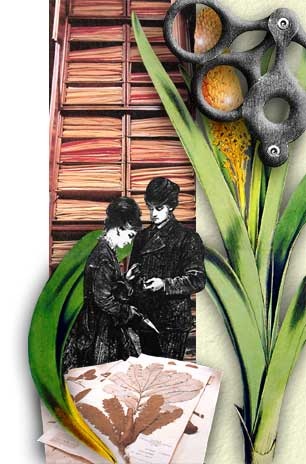 Botany was among the most popular of the nineteenth century sciences. Men,
women and children all joined in the frantic hunt for plants, and the hedgerows
were full of people cataloguing mosses, identifying ferns and pressing flowers.
This popularity had five main sources:
Botany was among the most popular of the nineteenth century sciences. Men,
women and children all joined in the frantic hunt for plants, and the hedgerows
were full of people cataloguing mosses, identifying ferns and pressing flowers.
This popularity had five main sources:
- Botany was easy – especially during the decades when the Linnaean or Sexual System of classification was in widespread use because it made most plants easy to identify.
- Botany was cheap – it required only a few, inexpensive tools: a tin box, known as a vasculum (pl. vascula) in which freshly-picked plants were placed; a small hand lens for identification; a book or two with which to identify and classify plants; and, a supply of clean paper used to dry, press and mount the plants.
- Botany was pious – the study of nature was a key aspect of natural theology, studying the creator's handiwork was supposed to confirm both his existence and his goodness and plants were considered especially appropriate for children and women to collect, since one could study them without having to observe animals copulating or killing each other.
- Botany was genteel and ladylike – it was widely considered unfeminine to kill or dissect animals, and even the bloodless pursuit of entomology required the collectors to asphyxiate the butterflies they gathered. By contrast, botany was readily associated with traditional feminine skills such as flower-arranging and flower-painting.
- Botany was healthy – like other natural history pursuits, it offered healthy, outdoor exercise and respectable opportunities in which to meet members of the opposite sex, based on a common interest in rational and improving activity. In many ways, botany was seen as a natural extension of the growing middle-class interest in gardening.
However, all these factors created problems for the small but influential group of Victorian botanists who wished to pursue full-time careers as botanists. The very things that made botany popular for some participants threatened its standing as a serious science in the eyes of others. One of the dominant themes in Victorian botany is the struggle between a self-appointed, predominantly male elite who were trying to redefine botany as a serious, "philosophical" science and the vast majority who wanted simply to enhance their understanding and enjoyment of flowers.
Created 2002
Last modified 18 July 2011